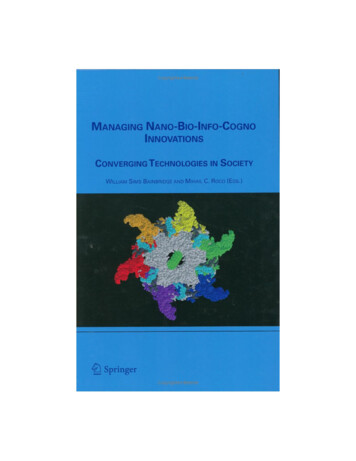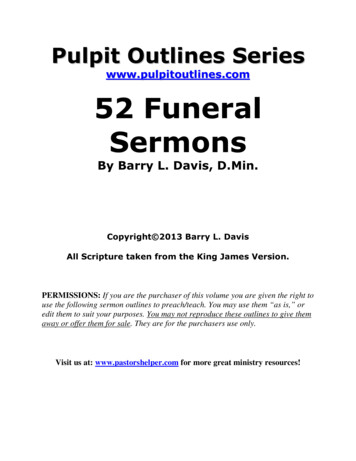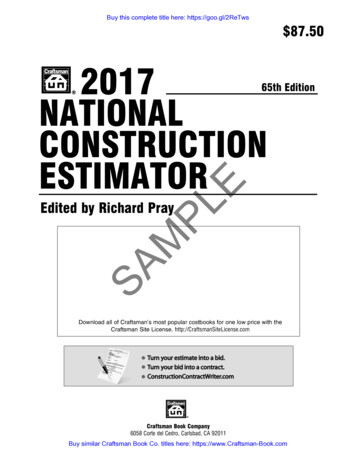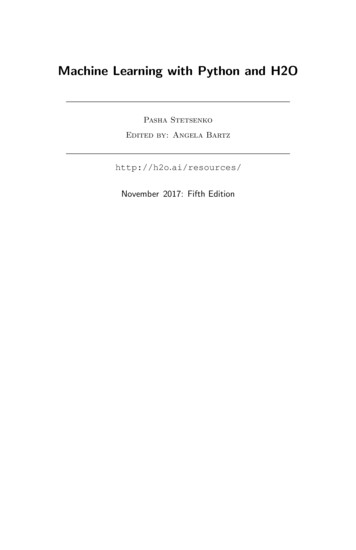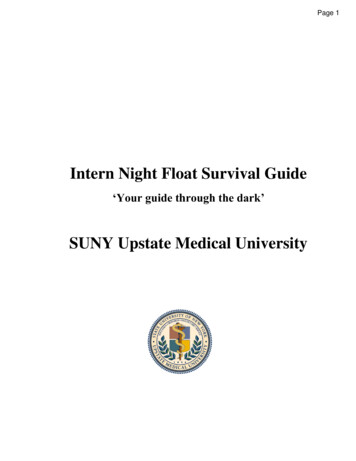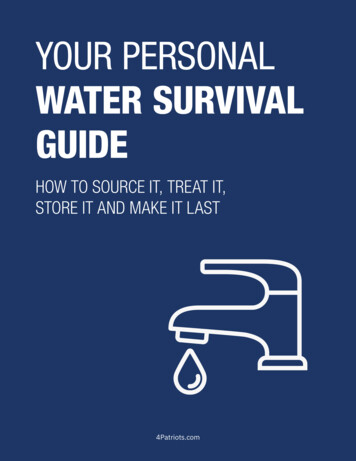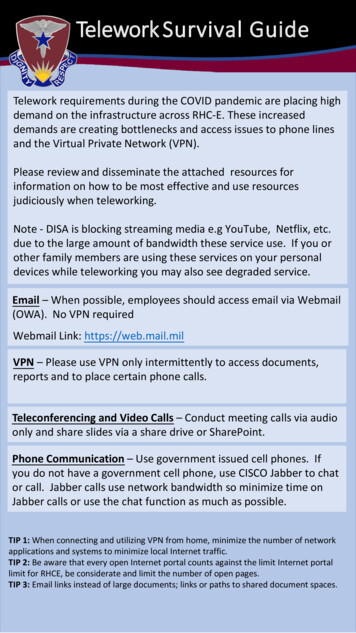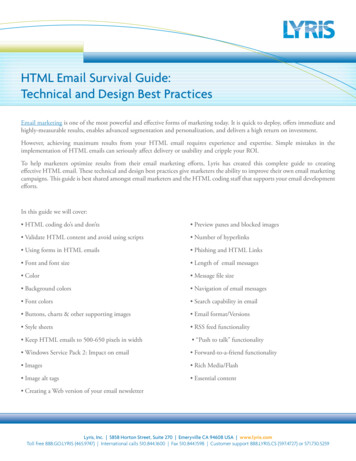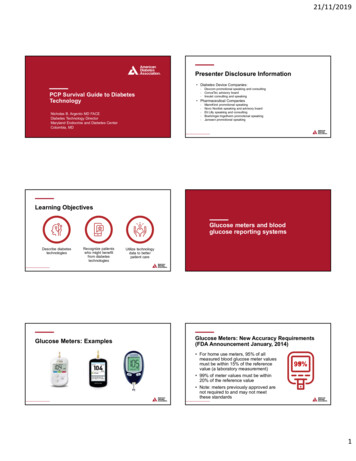
Transcription
21/11/2019Presenter Disclosure Information Diabetes Device Companies:PCP Survival Guide to DiabetesTechnologyNicholas B. Argento MD FACEDiabetes Technology DirectorMaryland Endocrine and Diabetes CenterColumbia, MD‐‐‐Dexcom promotional speaking and consultingConvaTec advisory boardInsulet consulting and speaking Pharmaceutical Companies‐‐‐‐‐MannKind promotional speakingNovo Nordisk speaking and advisory boardEli Lilly speaking and consultingBoehringer-Ingelheim promotional speakingJanssen promotional speakingLearning ObjectivesGlucose meters and bloodglucose reporting systemsDescribe diabetestechnologiesRecognize patientswho might benefitfrom diabetestechnologiesGlucose Meters: ExamplesUtilize technologydata to betterpatient careGlucose Meters: New Accuracy Requirements(FDA Announcement January, 2014) For home use meters, 95% of allmeasured blood glucose meter valuesmust be within 15% of the referencevalue (a laboratory measurement) 99% of meter values must be within20% of the reference value Note: meters previously approved arenot required to and may not meetthese standards99%95%1
21/11/2019Glucose MetersUploading glucose meter data has traditionally beendifficult for clinicians, with different meters requiringunique software and cablesMost diabetes specialists have downloaded only themost popular and supported brands of glucose meters(One Touch, Freestyle, Bayer)Diabetes Management SystemDiabetes Management System: Example One Touch Verio Flex &One Touch Reveal App Bluetooth-enabled glucosemeterPatient downloads appfrom App Store orGoogle Play or usesweb portalPatients can upload 100 different devices –glucose meters, CGM,insulin pumps, andfitnessPatients can enter BGreadings, food intake,exercise, insulindoses, etc.Data can also beupload to kiosk/tabletin provider’s office orat homeSmart PensSmart pens and dosingcalculatorsCompanion Medical InPen Smart Insulin Delivery Insulin dose calculation (0.5units) Insulin dose recording Active insulin/IOB data Insulin dosing reminders Incorporates Dexcom CGM data2
21/11/2019Smart PensNovo Nordisk’s NovoPen 6 andNovoPen Echo Plus 800 injection memory 5-year battery life Linked to Diasend/Glookomobile app and website Partnerships with Abbott and Dexcom apps and websitesContinuous glucose monitoring(CGM) technologyPatient case: John 74-year-old man with type 2diabetes On basal-bolus insulin Hypertension Hyperlipidemia, Chronic kidney diseaseG3b/A2 (ie eGFR 30-44,albuminuria 30-300 mg/g) Comes in to clinic for aroutine 3-month follow-upvisit.Smart PensEli Lilly Go Dose Insulin Pen & DosingCalculator App Coming soonPatientcase: JohnPatient case: John He presents with his daughterwho is concerned that her fatherlives alone and has had twosevere hypoglycemia episodesrequiring glucagon use in the lastyear. He is testing blood glucose4x/day with an averagefingerstick glucose of 125 mg/dLwith 18% of values 70 mg/dLand an A1C of 6.1%.3
21/11/2019Patient case: JohnWhich aspects of the patient’shistory would make youconsider CGM therapy?A. Episodes of severehypoglycemia requiringassistance from othersB. 8% of readings inhypoglycemia rangeC. A1C 6.1%D. All of the abovePatient case: JohnAnswer: D, All of the above A1C Goal -- factors to consider:Support systemVascular complicationsComorbiditiesLife expectancyDiabetes durationRisks associated with hypoglycemiaDiabetes Care Jan 2019, 42 (Supplement 1) S61-S70Diabetes Technol Ther, 19(Suppl. 2); S4-S11Lancet Diabetes Endocrinol 2016;4:893–902Medicare Coverage Requirementsfor Personal Therapeutic* CGM Have a diagnosis of diabetes, either type 1 or type 2 Use a home blood glucose monitor and conduct four or more daily testsContinuousGlucoseMonitoring inInterstitial Fluid Be treated with insulin with at least 3 daily injections/doses a day or a constantsubcutaneous infusion (CSI) pump Require frequent adjustments of the insulin treatment regimen, based ontherapeutic CGM test results Have been seen in office within 6 months, and Continue to be seen at least every 6 months in order to continue to receivecoverage*only CGM systems that have FDA approval for therapeutic use (fingerstick replacement) are coveredDexcom G5 MobileCGM SystemDexcom G5 CGM SystemA: glucose sensorB: transmitterC: receiving device, whichcan be either a receiver ormost smart phones and asmart watch7 days of sensor wear, records BG every 5 mins2-hour start up timeRequires two fingerstick calibrations per dayBlood glucose can be viewed on receiver, iPhone, Android phones, Applewatch, iPod, iPad, etc. Blood glucose level updated every 5 minutes with real-time alarms forhigh BG, low BG, urgent low BG 55 mg/dl, rise rate, and fall rate FDA approved as therapeutic CGM: treatment decisions do not requireconfirmatory BG check Mean Absolute Relative Difference (MARD) 9% 4
21/11/2019Dexcom Share Dexcom G5 CGM System Integration withT-Slim Insulin PumpDexcom G5 CGM SystemDexcom G5 CGM SystemDexcom Clarity App andWeb-Based ReportsDiabetes and Technology – CGMClarity options to empower patients:-opt in to email to inform the patienthow they are doing every week-push email notifications of whensomeone meets their glucose goalDexcom Clarity Appand Web-BasedReports5
21/11/2019Diabetes and Technology – CGMDexcom G6 CGM System 10 day sensor durationNo calibrations requiredPatient may choose to calibrateMARD 9% with no calibrationsNew ‘urgent low soon’ alertNo acetaminophen interferenceBetter sensor to sensorconsistencyMedtronic Diabetes: Guardian ConnectCGM SystemDiabetes and Technology – CGMDexcomG6 CGMSystemDiabetes and Technology – CGMSenseonics Eversense ImplantedGlucose Monitoring SystemDiabetes and Technology – CGMSenseonics Eversense Implanted Glucose Monitoring System Implanted sensor use time up to 90 days (6 months in EU)24-hour start up timeCalibrations: 4 on day 2, then every 12 hoursGlucose readings every 5 minutesSensor powered wirelessly by rechargeable transmitterMean Absolute Relative Difference (MARD) 8.6%Alerts and notifications are provided on mobile device and also as onbody vibe alerts Approved for treatment decisions without fingerstick verificationReal-Time vs. Intermittently Scanned CGM Real-time CGM (rtCGM): continuously reports glucose levels and includescustomizable alarms for hypoglycemia and hyperglycemic excursions. Intermittently Scanned CGM (isCGM): measures glucose in interstitialfluid through a filament inserted under the skin. (Adult use only)‐‐Home use version: patient carries receiver or smart phone to see real-time glucosevalues only when scanned over sensorBlinded professional version: Libre Pro- patient does not carry receiver, single 14day session with data downloaded during office visitEdelman et al, Diabetes Care 2018;41:2265–2274/nba6
21/11/2019Diabetes and Technology – isCGMFreestyle LibreFlash GlucoseMonitoringSystemDiabetes and Technology – CGMFreestyle LibreFlash GlucoseMonitoringSystemDiabetes and Technology – isCGMFreestyle Libre Flash Glucose Monitoring System 14 days of wear, updates every minute, records MBG every 15 mins 1-hour start up time No calibrations required, cannot be calibrated if inaccurate Approved for use for treatment decisions under most circumstances Fingerstick BG recommended for treatment decisions when sensor data notcorrelating with how patient feels, when BG changing rapidly or no trend arrow,impending low, reading 70, and during the first 11 hours of sensor life Does not give high or low BG alarms- the user must scan to receive any BGdata and at least every 8 hours to capture full glycemic history Mean Absolute Relative Difference (MARD) 10.1%, with a high false positiverate for readings below 70 mg/dl*FreeStyle Libre User’s Manual, *FDA Summary of Safety and Efficacy for 14 day Freestyle LibreDiabetes and Technology – isCGM ReportsProfessional CGM: Short Term UseMedtronic iPro 2Freestyle Libre ProDexcom G6 Pro*Freestyle LibreFlash GlucoseMonitoringSystem 6 day disposable sensor 14 day disposable sensor 10 day disposable sensor Reusable transmitter Combined sensor-transmitter Disposable transmitter Blinded results Blinded results Blinded or unblinded results 2 calibrations a day No calibrations No calibrations Patient returns reusabletransmitter for download Patient returns disposablesensor-transmitter fordownload Patient returns receiver device fordownload, or uses smart phone fordownload via Clarity* Dexcom G6 Pro FDA approved and available early 20207
21/11/2019Diabetes and Technology – CGM OutcomesPersonal CGM Use 2010-12 vs 2015-17 indifferent age groups in T1D ExchangeSTAR 3 Study7 ' ([FKDQJH ' DWD RQ & * 0 1 5HIOHFWV GDWD IURP t Bergenstal RM, et al. N Engl J Med 2010;363:311-20.A1c results in T1D Exchange by ageand treatment groupHave LowerHbA1c than SMBG Regardless of Insulin Delivery MethodTime in Range (TIR) Despite increased CGM adoption, data use is low Unlike A1C, CGM and SMBG allows for direct observation of glycemicexcursions and daily profiles to inform immediate therapydecisions/lifestyle modifications Common metrics and standardized reports with visual cues have beencreatedDiabetes Care 2019;42:1593–1603)RVWHU HW DO & RQWLQXRXV * OXFRVH 0 RQLWRULQJ LQ 3DWLHQWV : LWK 7\SH ' LDEHWHV 8 VLQJ ,QVXOLQ ,QMHFWLRQV ' LDEHWHV & DUH H tH Standardized CGM Metrics for Clinical Care1. Number of days CGM worn (recommend 14 days)2. Percentage of time CGM is active (recommend 70% of data from 14 days)CGM Time in Target InternationalConsensus Panel Recommendations3. Mean glucose4. Glucose management indicator (GMI): MG 155 GMI of 7.0%*5. Glycemic variability (%CV) target 36%**6. Time above range (TAR): % of readings and time 250 mg/dL ( 13.9 mmol/L)Level 27. Time above range (TAR): % of readings and time 181–250 mg/dL (10.1–13.9 mmol/L)Level 18. Time in range (TIR): % of readings and time 70–180 mg/dL (3.9–10.0 mmol/L)In range9. Time below range (TBR): % of readings and time 54–69 mg/dL (3.0–3.8 mmol/L)Level 110. Time below range (TBR): % of readings and time 54 mg/dL ( 3.0 mmol/L)Level 2Use of Ambulatory Glucose Profile (AGP) for CGM report*GMI calculator: https://www.jaeb.org/gmi/ **CV, coefficient of variation. *Some studies suggest that lower %CV targets ( 33%) provideadditional protection against hypoglycemia for those receiving insulin or sulfonylureasBattelino et al, Diabetes Care 2019;42:1593–16038
21/11/2019AmbulatoryGlucoseProfilePatient case: Maria 59-year old patient Type 2 diabetes for 18 yearsPatientcase: MariaPatient case: Maria She is frustrated with her A1Clevel not correlating with herisCGM glucose averages whenreviewing 30 and 90 day reports. Her A1C level is typically 0.50.7% higher than her predictedA1C level based off her isCGMreport statistics.Patient case: MariaPatient case: MariaWhich of the following glucosemetrics is thought to be at least asimportant as the A1C level?Answer: E All of the above whencombined into a standardizedCGM reportA. Average glucoseB. Percent of time sensor is wornC. Glucose variability measuredby standard deviation orcoefficient of variationD. Time in RangesE. All of the above whencombined into a standardizedCGM reportDiabetes Care 2019;42:1593–16039
21/11/2019Glucose Management Indicator (GMI) neededbecause measured A1c often differs frommeasured MBGInsulin pump therapyBeck et al, Diabetes Care Aug 2017;40:994–999Insulin pump therapy: only 3 now availableInsulin Pump Therapy Features common to insulin pumps: Bolus calculator based on carbs and BGlevel Temporary basal rates ( or -) Active insulin/insulin duration ( 2-6hours) 200-300 unit capacity /- water proof or ‘splash proof’Medtronic 670G Hybrid Closed-LoopSystemHybrid/integrated insulin pump& CGM technology10
21/11/2019Medtronic 670G Hybrid Closed-LoopSystemMedtronic 670G Hybrid Closed-LoopSystem Guardian Sensor 3 and Guardian Link 3Transmitter 7 days of sensor wear, updates BG every 5mins 2-hour start up time Calibration required every 12 hours, 3-4 aday recommended Mean Absolute Relative Difference (MARD) 9.6% with 3-4 calibrations/dayMedtronic 670G Hybrid Closed-LoopSystem Smartguard Technology in Auto Mode Algorithm targets BG level of 120 mg/dl or 150 mg/dl Automatically adjust basal insulin delivery every 5 minutes based on CGMreading to target 120 mg/dl Correction boluses automated to target 150 mg/dl Decreases or suspends insulin delivery up to 30 mins before hitting presetlow BG limit (50-90 mg/dl) Can increase basal delivery to 2.5x normal for up to 4 hours Calculates basal rates and correction doses based on last 6 days of totaldaily insulin dose (TDD) Exits auto mode and reverts to programmed basal when sensor notavailable or relaible, pump occluded, or unstable BGMedtronic 670G Hybrid Closed-LoopSystemMedtronic 670G Hybrid Closed-LoopSystemAuto Mode Exited When: The sensor is in its warm-up phase The sensor is not communicating with the pump The sensor requires calibration There is a significant discrepancy between the sensor and the calibration value Minimum basal delivery has taken place for 2.5 hours Maximum basal delivery has taken place for 4 hours Glucose is above 300 mg/dl for more than an hour Glucose is above 250 mg/dl for more than 3 hours An occlusion is detectedMedtronic 670G Hybrid Closed-LoopSystemPivotal Trial (n 30 adolescents ages 14-21 and n 94 adults ages 22-75; 2 weeks manualmode followed by 3 months auto mode)Adolescents Used system 75.8% of timeAdults Used system 88% of time A1C 7.7% 7.1% (p 0.001)Time in range (71-180 mg/dl) 60.4% 67.2% (p 0.001) A1C 7.3% 6.8% (p 0.001)Time in range (71-180 mg/dl) 68.8% 73.8% (p 0.001) Time 70 mg/dl 4.3% 2.8%(p 0.00928)Within-day standard deviation 56.4mg/dl 51.4 mg/dl (p 0.001) Time 70 mg/dl 6.4% 3.4%(p 0.001)Within-day standard deviation 40.0mg/dl 38.0 mg/dl (p 0.065) Garg SK, et al. Diabetes Technol Ther 2017;19(3):155-16311
21/11/2019Medtronic 670GHybrid ClosedLoop SystemMedtronic 670G Hybrid Closed-LoopSystemTandem t:slim X2Basal IQ systemTandem t:slim X2 Basal IQ systemTandem t:slim X2 Basal IQ systemTandem t:slim X2 Basal IQ systemn 103, age 6–72 years, mean A1C 7.3% participated in a 6-weekrandomized crossover trial Used system 90% of timeMedian time 70 mg/dl 3.6% 2.6% (p 0.001)31% reduction in time 70 mg/dlNo change in mean glucose concentration 159 vs. 159 mg/dlMean pump suspension time 104 minutes/dayFuture Closed-Loop ArtificialPancreas TechnologyForlenza GP, et al. Diabetes Care 2018;41(10): 2155-216112
21/11/2019Closed-Loop Artificial PancreasTechnologyT-SlimX2 Dexcom G6 Control IQHybrid Closed Loop 168 adults with T1D, baseline A1c, randomized 2:1 to closed loop(CL) or open loop controls, primary outcome time in range over 6months2ndhalf of2019 100% of subjects completed the study, closed loop were in loop90% of the time The mean percentage of time in range increased in the closed-loopgroup from 61 17% to 71 12% during the 6 months and remainedunchanged at 59 14% in the control group (P 0.001) Most effective at night, CL in range 92% of the time by 7 AM A1c, mean BG, time above range, time below range all improvedsignificantly in CL vs no change in controlsSA Brown et al. N Engl J Med 2019. DOI: 10.1056/NEJMoa1907863Omnipod Horizon Hybrid Closed-LoopSystem Insulet partnered with Dexcom andTidepool Tidepool working on app & hybridclosed-loop algorithm Expected second half of 2020The FDA has made no statementsregarding the off-label use of diabetestechnologies, products, and devices, butis monitoring the situation closely?True?Closed-Loop ArtificialPancreas Technology Multiple companies are working onhybrid closed-loop and closed-loopsystems.‘Open source’ closed-loopinsulin pump & CGM systemsFalse?13
21/11/2019‘Open source’ closed-loop insulin pump &CGM systems: OpenAPSThe Open Source Artificial PancreasSystem (OpenAPS) https://openaps.org/The basic setup requires: insulin pump (older Medtronic) a compatible a CGM (Medtronic or Dexcom) a small computer (Intel Edison or RaspberryPi for example) and a radio board/stick a battery Allows more aggressive targets thanapproved systems Being used by thousands of patients‘Open source’closed-loop insulinpump & CGMsystems: OpenAPS‘Open source’closed-loop insulinpump & CGMsystems: LOOPNOTFDAapproved‘Open source’ closed-loop insulinpump & CGM systems: LOOP LOOP app on iOS devices Utilizes FDA-approved Medtronic andOmniPod pumps and Dexcom or MedtronicCGM Utilizes Loop app dosing algorithm andexternal hardware (small computer likeRiley Link)Diabetes and Technology Off-Label Use ofFreestlye LibreCGM MIAOMIAO14
21/11/2019Off-Label Use of Freestlye Libre CGM AmbrosiaSystemsBluConDiabetes and TechnologyOff-Label Use of Diabetes TechnologiesFDA Warns Against the Useof Unauthorized Devices forDiabetes ManagementMay 17, 2019“Millions of Americans use continuous glucosemonitors and insulin delivery devices to monitor andtreat their diabetes. Because of the complexity ofthese devices and the life-saving care they provide,it’s important that patients are aware of the risks thatarise when they’re not used as intended or when theyuse devices not authorized for sale in the U.S. Byusing products that have not been reviewed by theagency for safety and effectiveness, patients withdiabetes may be putting themselves at risk forserious injury or even death.”Additional CE Credits: Online: Self-Assessment Program and webcast on Diabetes Technologyfor Primary Care Print: Diabetes Technology: Science and Practice Patient Resource:‐Diabetes Forecast Consumer Guide15
Dexcom Share Dexcom G5 CGM System Integration with T-Slim Insulin Pump Dexcom G5 CGM System Dexcom G5 CGM System Dexcom Clarity App and Web-Based Reports Clarity options to empower patients:-opt in to email to inform the patient how they are doing every week-push ema
